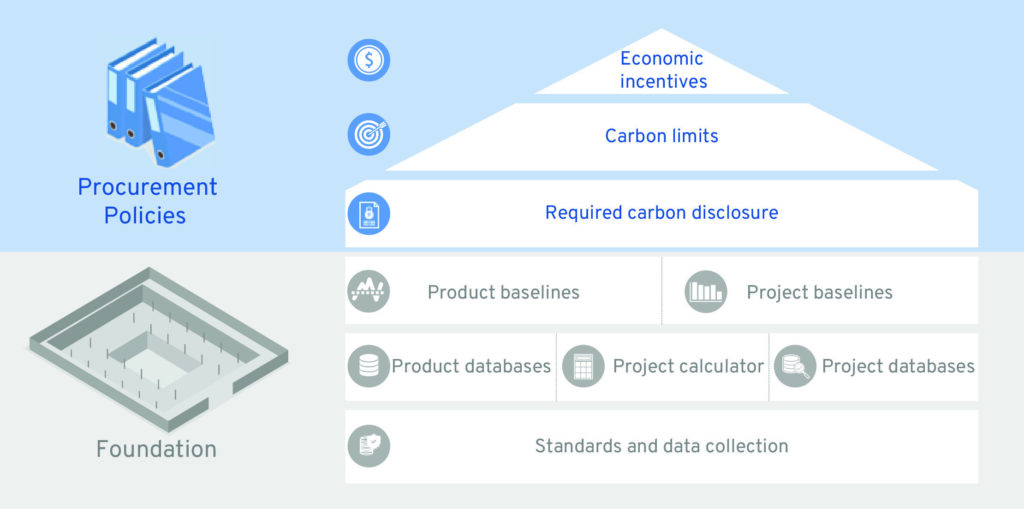Editor’s Note: Much has been written about efforts around the world to lower the built environment’s carbon footprint. As concrete is the most widely used building material in most countries, technology and policy advances affecting its production and use are significant factors in this effort. Recently published by the World Economic Forum and reproduced here with permission, this article addresses the progress made in six countries to lower concrete-related carbon emissions.
__________________
By: Jörgen Sandström, Head of Energy, Materials, Infrastructure Programme, Industrial Transformation, World Economic Forum. Yvonne Leung, Lead, Industry Decarbonization, Concrete and Cement, World Economic Forum. Joerg Hildebrandt. Managing Director & Senior Partner, Boston Consulting Group. Kate Martin. Project Leader, Boston Consulting Group
August 4, 2022 – Demand for cement – the key ingredient in concrete – is soaring on the wings of a global infrastructure and building boom driven by the expansion of both developing and developed economies. Many of these projects are much needed and will improve the quality of life and create jobs for millions of people. But they carry with them a troubling by-product: the cement industry generates approximately 7% of global CO₂ emissions. Meeting climate change goals – specifically, limiting the global average temperature increase to 1.5°C above pre-industrial levels – will not be possible without aggressive action to decarbonize concrete production.
Any attempts to address carbon emissions from concrete must begin with the public sector. National, regional, and local governments and agencies comprise 40% to 60% of concrete sales and 20% to 30% of construction industry revenues. All told, public sector procurement accounts for 12% of global GDP and 15% of global carbon emissions. Abating these emissions will lead to an estimated $4 trillion boost to the green economy, create around 3 million net new jobs and considerably reduce the social cost of carbon, according to a report released by the Forum earlier this year. However, the reality is that the progress we are seeing today does not put us on track to reach net zero by 2050. Getting to net zero requires all governments – first and foremost the biggest emitters – to take bold, immediate steps towards reducing emissions now.
A low carbon concrete procurement model
Six countries – the Netherlands, Sweden, Germany, France, the United Kingdom and United States – are in the vanguard of adopting low carbon concrete and construction rules and green procurement policies. Based on interviews with construction and procurement experts from the public and private sectors in these countries, Low Carbon Concrete and Construction: A Review of Green Public Procurement Programmes examines the tools and policies they have adopted to support a shift to low carbon concrete. The report is presented by Mission Possible Partnership (MPP), an alliance of climate leaders focused on supercharging decarbonization across the entire value chain of the world’s highest-emitting industries in the next 10 years. It was developed by the Concrete Action for Climate Initiative (led by the Forum and the Global Cement and Concrete Association) in collaboration with Boston Consulting Group.
Emerging from these countries is a blueprint for low carbon concrete and construction that contains two facets (see graphic below):
-
The foundation is a set of common standards for assessing the carbon emissions of concrete, other building products and completed projects. It also generally includes a product database for collecting and storing carbon emissions information and baselines of materials, including concrete. Similar databases and baselines can also be established for whole projects.
-
Procurement policies determine rules for the disclosure of carbon in concrete products and projects, which are essential for data collection in the foundation stage. In addition, procurement policies are needed to set targets for carbon emissions reduction. To meet these targets, mandates and incentives should be adopted.

Global collaboration is needed
While these countries have made strides in developing low carbon concrete programmes, they are just at the beginning of their efforts and much more needs to be done. As their green procurement initiatives progress, they should be measured and refined continually, becoming more ambitious over time, and ideally aligning to the targets set forth in the Paris Agreement. To enable this, public and private sector stakeholders across the globe must work together. “Collaboration, innovation and sharing of knowledge between all players involved is essential,” says Albert Manenschijn, Principal Consultant for Rijkswaterstaat, the Ministry of Infrastructure and Water Management in the Netherlands. “It enables consistent and coordinated green public procurement, which is a key building block towards accelerating the concrete industry’s transitions toward net zero.”
In addition, low carbon concrete approaches must take hold in emerging nations, which will be responsible for much of the world’s future concrete demand. Rapid infrastructure expansion is crucial in those countries – and economic policies generally focus more on quick construction of housing, roads, bridges, hospitals and schools than on meeting climate change goals. It will be important to scale and adapt green public procurement tools and policies so that developing countries can afford to implement them without sacrificing their growth.
First movers in government and the private sector
One promising international campaign to reduce carbon emissions in built projects is the Industrial Deep Decarbonisation Initiative (IDDI), coordinated by the United Nations Industrial Development Organization (UNIDO). The IDDI hopes to obtain commitments from at least 10 countries to begin to adopt low-carbon steel and concrete procurement policies within the next three years.
In the end, the private sector’s engagement in low carbon concrete procurement and construction will be critical as well. To buoy public and private sector participation, the First Movers Coalition (FMC) is harnessing the purchasing power of companies and governments (currently with 10 governments partners: US, Germany, Japan, Sweden, Denmark, Singapore, United Kingdom, India, Italy and Norway) to decarbonize seven “hard to abate” industrial sectors, including concrete. FMC members agree to purchase a portion of the industrial materials they need from suppliers using near-zero or zero-carbon solutions.
The path to a 1.5°C goal has a lot of moving parts – and reducing carbon emissions from concrete is just one of them. But the existing initiatives to address this crucial issue and the knowledge gained from them can hopefully provide the beginning of a roadmap for establishing and scaling green public procurement programmes within and among countries.
![]()






